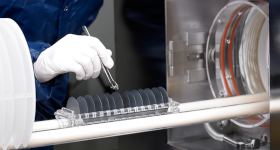Wet Oxidation
Wet oxidation is used for growing thicker (> 100 nm) layers of silicon dioxide for applications such as isolation (field oxides and local oxidation) and dopant diffusion barriers, in which oxide quality is less important.
There are three (3) popular methods of Wet Oxidation:
| Option | Advantages | Disadvantages |
|---|---|---|
| Flash Vaporizer Oxidation | Good for thick and thin oxides, good uniformity. | Cost |
| Pyrogenic Oxidation | Inexpensive, clean, all-gas system, good uniformity | Not suitable for thick oxides because of torch burn. Incurs hydrogen's safety risks. |
| DI Water Bubbler Oxidation | Moderate price, acceptable uniformity for thick oxides | Thin oxides have non-uniformity issues. Cool water vapor causes temperature disturbances. Slower since process gas is only half steam. |
-
Typical Film Thickness:
- 500 nm at 1,000 °C (flat) using DI water method
- < 50 nm at 1,000 (flat) using pyrogenic method
-
Maximum Film Thickness:
- 20 μm at 1,000 °C (flat) using DI water bubbler
- 3 μm at 1,000 °C (flat) using pyrogenic method
-
Batch Size:
- 100 in 18 flat zone
- 200 in 34 heater
- Oxidation Rate: Standard Chart Rates Deal-Grove for both methods
- Oxidation Gases: Hydrogen/Oxygen (Pyrogenic only), DI H2O Steam
- Oxidation Temperature: 800 - 1250 °C
- Refraction Index: 1.4 - 1.47
-
Uniformity
- < 3% 1σ at thickness < 2000 Å
- < 2% 1σ at thickness > 2000 Å
Applications: optical waveguides, insulation, isolation (field oxides and local oxidation), dopant diffusion barriers



